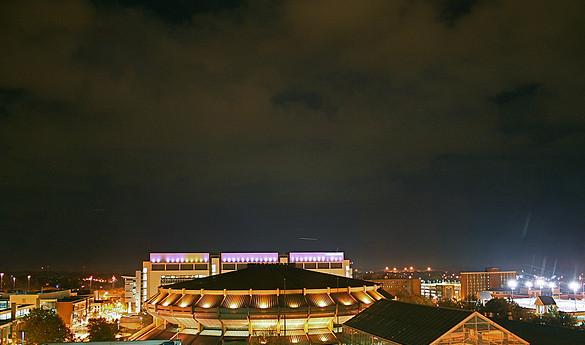City of Richmond bids farewell to 24-year March tradition in CAA tournament
The city of Richmond has been the heart of the Colonial Athletic Association men’s basketball tournament for 24 years. However, next year when March rolls around, the Richmond Coliseum, that hosts the event, will be missing its weekend attraction as the tournament moves north to Baltimore.
Though its reign as the tournament’s location comes to an end, Richmond and the Richmond Coliseum was the setting for many memories in its over two decades as the CAA host city.
Originally, the CAA tournament had been held on college campuses, alternating locations year-to-year (the Patriot Center hosted the 1986 CAA tournament). At the time, Navy was the northernmost representative with East Carolina University as the southernmost school. Richmond was an optimal site for the tournament to be held, being centrally located geographically and in the state capital of Virginia, where a majority of the CAA schools were situated.
“Richmond provided an attractive proposal with many corporate sponsors and the deals with the city were substantially better than others,” said Tom Yeager, the first and only commissioner the CAA.
The Richmond Coliseum, built in 1971, was a venue that attracted numerous musical acts and was, at the time, a viable option as a host arena. It offered a consistent location for the tournament and in partnership with the city of Richmond, allowed the two parties to help each other, driving tourism and boosting the metropolitan economy.
In 1990, the building became the host of the CAA men’s basketball tournament and would remain a fixture of the conference for 24 years.
“We work very hard to make it more than just a series of basketball games by providing other entertainment including live music and things for the family to enjoy,” Yeager said.
In 2005, Virginia Commonwealth University’s Sports Marketing Group, InZone Research compiled an economic impact analysis of the CAA tournament in Richmond. In the study, the group found that the tournament provided $4.9 million to the Richmond metropolitan area economy.
Since then, the CAA has been vastly successful in the postseason, with original member George Mason making a Cinderella-like run to the 2006 Final Four and VCU following suit, en route to the 2011 Final Four. With the growth of recognition for the conference, the CAA tournament became more of a draw for not just fans of the schools, but college basketball fans in general.
According to another study conducted by Director of the Center for Regional Analysis Stephen Fuller at George Mason University in 2009, the annual attendance of the tournament increased by 34 percent between 2005 and 2009. In the five-year period, the overall attendance of the event leaped from over 31,000 to over 42,000 for the weekend.
The study focused on the economic impact of the CAA men’s basketball tournament at alternative sites, including Washington, D.C. and Philadelphia, Pa. Fuller concluded that by hosting the event in a metropolitan area with a large and complex economy, it would directly benefit the metropolitan areas’ economy. For instance, had the tournament been held in Philadelphia, the revenue generated could reach as much as 88 percent higher compared to the economic impact of hosting the tournament in Richmond.
Amongst fans, there has been a long-standing concern for the neutrality of the site, being mere blocks away from the VCU campus. However, with the school’s departure from the CAA in July 2012, the timing was right to change locations.
Last November, the CAA signed a three-year contract with the city of Baltimore to host the men’s basketball tournament in the city’s First Mariner Arena.
“The leadership of [the organization] Visit Baltimore and the reps from Baltimore impressed us,” said Yeager. “Baltimore and the Inner Harbor is a renowned tourist destination and as the conference changes geography, it’s a more central location for our schools.”
Taken into account, the size of the city and the city’s economy may have had an impact on the decision to move the tournament’s location, but a number of factors played into the final choice of Baltimore.
For one, the Inner Harbor is a profitable tourism destination for the city and would provide a strong business investment for both the CAA and the city of Baltimore. Though the arena is older than the Coliseum—built in 1961—it underwent renovations in the late-80s to accommodate more seats. When the CAA moves to Baltimore, the conference intends to stay put for the long haul.
“We have every expectation to keep it [in Baltimore],” Yeager said. “After the three-year contract expires, we will take a step back and look at the options and find what is in the best interest of the conference.”
The time that the tournament has spent in Richmond has been memorable, especially for Yeager, who has seen the growth and change of the event over time.
“Over the 24 years, I’ve built up a lot of great relationships, personally and professionally with the ticket takers, ushers and all the people who work like crazy behind the scenes,” Yeager said. “There have been some great memories like that of climbing a ladder with a pair of scissors in their hand. There aren’t too many moments like that one.”

